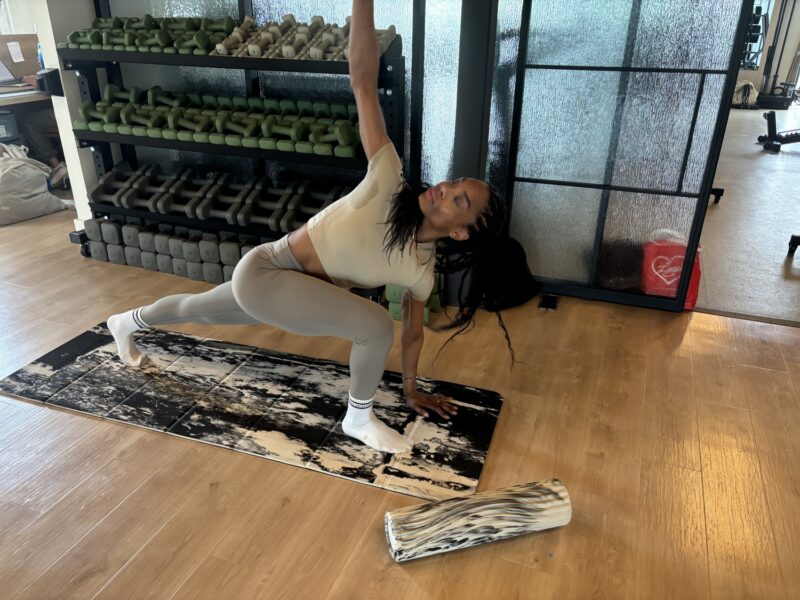

“Live simply so that others might simply live” — Mahatma Gandhi
The first time I hiked in a rain forest in Costa Rica, I was prepared. Really prepared. My SPF 50 fabric backpack was busting at the zippers with very necessary accessories: A microfiber cooling towel. A waterproof pen. Carbon fiber contractable hiking poles. I had National Geographic Night Vision Binoculars in case it got too shady. A portable titanium coffee cup, in case I ran into someone in the forest who wanted to pour me a cup of coffee. And bear spray, in case we were attacked by a probably extinct jaguar. I could survive anything on our one hour hike.
Then we came across a woman walking at a leisurely pace in high heel sandals and a skirt. Her jungle attire turned out to be just like that of most women in rural Costa Rica.
That was my Grinchy lightbulb moment. Maybe hiking, perhaps, doesn’t come from a store. Maybe hiking, perhaps … means a little bit more. What if exercise could be done without all the doodads and gismos? What if we could burn calories without burning so much fossil fuel?
Making exercise more sustainable is surprisingly simple.
The most sustainable clothes are the ones you’ve been wearing for years. Take the basic tee. A single cotton T-shirt puts into motion a global chain of events, spewing pollution every step of the way. Growing cotton for just one shirt consumes 713 gallons of water, 150 grams of pesticides, and bleeds chemical dyes into rivers and farmland. Its carbon-fueled journey from raw material to shop floor takes an average of 18,000 miles. When you take this into account, does anyone really need another T-shirt?
Even at a charity fundraiser where competition swag is everywhere, Just Say No to free stuff. The less merch we take, the less is produced, so more of the profit goes to the charity.
Treat your clothes better so they last longer. If you’re not a repair and repurpose kind of person, a lot of major sports brands take back their old gear and clothing, then repair and resell it to keep stuff out of landfills. REI’s Re/Supply Program, Patagonia’s Worn Wear or The North Face’s Clothes the Loop are all programs that give clothes a second life.
While major brands only take back their own merchandise, local thrift shops like the LVIS and The Retreat Boutique take athletic clothing and offer a respectable selection of yoga, running and golf clothes.
When you do you buy new, choose clothes made from sustainable material such as hemp, bamboo, recycled polyester and organic cotton, which is grown without pesticides, herbicides, or chemical fertilizers. These fabrics are usually more durable and cozy. Avoid synthetic fabrics like polyester and nylon, which are derived from petroleum and release toxic microplastics in the wash.
With workout equipment, almost everything can be acquired second hand. Online websites like The Pro’s Closet buy, tune up and resell a huge variety of high end bikes, often for rock bottom prices. SidelineSwap, called, “the eBay of sports equipment,” has a big inventory, and it’s really easy to navigate. Selling or buying on Facebook Marketplace also keeps stuff out of the landfill. Because you’re buying local, there’s less CO2 emitted in shipping, and you get a level of transparency from meeting the seller.
The most eco-friendly sports all have a few things in common: They require little to no equipment. And they use the world’s natural geography as their playing field. Running, hiking and walking are really sustainable sports because of their simplicity, requiring only your body and a good pair of shoes.
Scenery matters. Never underestimate the restorative power of exercising in nature. From reducing stress levels and blood pressure to improving mental health, the endorphin hit from exercising is enhanced when you train outside. It’s also been tied to improved cognitive function and better sleep.
Luckily, living in the Hamptons is like being in one of those simulated videos that they use in a spin class: The montage of peaceful woods, seaside cliffs and farm fields that is probably shot here in the Hamptons. This summer, try taking a run on the beach, kayaking on the Napeague Bay, hiking in the dunes of Hither Hills, or doing yoga at Channing Daughters Winery.
When it comes to improving agility and coordination, the very best treadmill can’t match the challenging terrain of the great outdoors. Even an open water swim, with its varied “terrain” of currents, wind speeds and temperature changes is better for building endurance and boosting your immune system.
For an extra sustainable sprint, improve your surroundings by “plogging.” This fitness trend started in Sweden and simply means “plucking” litter while on a jog. Great for your inner multitasker.
How you get to your sport can be a big contributor to CO2 emissions, even when not flying to Costa Rica. Start your work out from where you are. Switch out driving to walking, biking or e-biking and add a little cardio boost to your routine.
Biking is especially eco-friendly if you make biking into town a summer sport. AAA estimated that 39.4 million people nationwide were traveling by car over Memorial Day weekend (up a million from last year). It seemed to me that most of them came to the Hamptons. Getting around on a bike is much faster than sitting in bumper-to-bumper traffic. Then once in town, you avoid the time-honored sport of finding a parking place.
If exercising al fresco doesn’t feel like it has the same bodybuilding factor as lifting weights in a gym, consider “Rucking.” The Marines introduced walking with a backpack (or “rucksack”) as a serious way to combine building strength, stamina and bone density. A 155-pound person who burns about 430 calories per hour jogging at a moderate pace can burn 100 calories more in the same time by walking four miles an hour carrying a 20-pound pack. While Marines describe rucking as intense cardio training, it can also be called walking to the store for groceries. (It’s possible to ruck on a treadmill, but that kind of defeats the purpose). The only gear you need here is a sturdy backpack and cans of food, water bottles, or books as barbells.
Open water swimming, also known as, “wild swimming,” is more sustainable than swimming indoors, and in my experience, a lot more fun. Less overhead. Less chlorine. More scenery. Coach Tim Treadwell, of the Open Water Swimmer Training program in East Hampton, describes it as swimming in a pool created by nature where, “Most people like fresh water and fresh air.” Remember to keep a distance from Piping Plover nesting sites on the beach, and always use “reef safe” sunscreen and bug spray to avoid polluting the bays.
With all sports, stay hydrated sustainably by investing in a reusable stainless-steel water bottle. Even if you’re reusing a plastic water bottle to avoid waste, plastic bottles leach chemicals and microplastics into the water; especially on a hot summer day in the delivery truck.
In Costa Rica, pura vida in Spanish literally means, “pure life.” I also came to understand that the phrase means a lot more. It’s also a kind of greeting emphasizing a way of life that focuses on the simple things.
Pura vida planet fans!
More Information:
Dawgpatch Bandits (dawgpatchbandits.com): Nonprofit creating awareness around how fitness supports mental health. Open Air Fitness Training — Saturday morning, 8 a.m. Open Water Swim — Tuesday morning, 7:30 a.m. Both at Long Beach, Sag Harbor. Free to all.
Surfrider Foundation (easternli.surfrider.org): Join this ocean loving crew to help protect our waters and social events. Beach clean Up: June 28th, Montauk. Surf Movie Night: Variety of surf movies. Local vendors. September 12 at Southampton Arts Center. One Ocean Gala: Raises funds to protect the world’s oceans and beaches. Auction. Local artists. August 9 at The Crow’s Nest in Montauk.
STAR Summer Splash (staraquacenter.org): Open water swim. Choose between a one mile, 1/2 mile, or 1/4 mile swim. August 9, 7 to 10 a.m., Long Beach, Sag Harbor.
Open Water Swim Training (ehamptonny.gov): Run by the town of East Hampton, swimmers improve open water skills, do distance and interval training and learn how to stay safe. Meets Tuesdays and Thursdays 7 at a.m. starting June 24. Ten weeks for $45.
 More Posts from Jenny Noble
More Posts from Jenny Noble